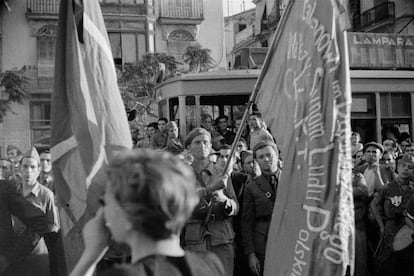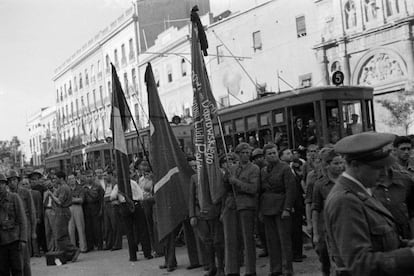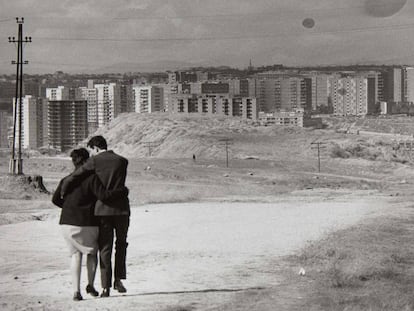Trove of unseen photos shows Gerda Taro and Robert Capa in action
Images taken by a Polish doctor captured the world-famous photographers during the Spanish Civil War

Just weeks after a previously unseen image emerged of Gerda Taro, showing the war photographer in the last moments of her life, another unpublished photo has been identified by the Documentation Center of Historical Memory (CDMH), located in the Spanish city of Salamanca.
Just dug out this photo of a young doctor with the International Brigade in the Spanish Civil War in 1937 - my father. pic.twitter.com/QY02OAcYOP
— John Kiszely (@johnkiszely) January 16, 2018
In this new image, Trato is photographed from behind on June 12, 1937 as she snaps the Dabrowski battalion during a tribute in Valencia to Hungarian General Lukacs (Máté Zala), who had died a few days earlier at the Huesca front during the Spanish Civil War. The moment was captured by Emilio Rosenstein, a Jewish Pole who fled to Paris in 1928 to escape the anti-Semitism of universities back home and study abroad.
When the Civil War began, Rosenstein, who was by then a doctor, decided to join the International Brigades and fight in defense of the Spanish Republic. He changed his name to Emil Vedín to protect his family back in Poland, and became one of the most important documentarians of the Spanish Civil War.
Rosenstein’s unpublished photo of Taro invites viewers to see the scene through her eyes
As a doctor and a photographer, Vedín provided unparalleled insight into the conflict. His nearly 1,000 frames, preserved by the Salamanca archive, depict life at the front, the rearguard, in exile, from the point of view of a Jewish doctor, bringing together precise moments and fragments in time that humanized the war and those persecuted by it. His daughter Yvonne Jane Rosenstein Azoulay donated his works to the CDMH in Salamanca, and, as well as enriching the center’s documentary heritage, these images have also led to some surprises.
Rosenstein’s unpublished photo of Taro invites viewers to see the scene through her eyes. Less than six weeks later, a Republican tank would accidentally take her life in Brunete. It is not known if the doctor was aware he was taking a photo of Taro. Did he know her? It is possible given he also snapped her partner, war photographer Robert Capa, at the same event.
In this second unseen photo, Capa is not the focal point. A discerning eye is needed to spot him, camera in hand, and the resulting image not as intimate as the photo of Taro.

Taro’s photos from the day are preserved at the International Center of Photography (IPC) in New York. Also present the day that Rosenstein’s photos were taken were Republican prime minister Juan Negrín y López, general staff of the Armed Forces General Vicente Rojo, the minister of agriculture Vicente Uribe, and Jesús Hernández, who was in charge of education and health in the government – subjects for both Rosenstein and Taro. But Taro also included anonymous women in her photographs, capturing the nameless victims and protagonists of a summer day in which she, too, was also caught in the unwavering gaze of a fellow photographer.
María José Turrión belongs to the State Corps of Archivists and is the former director of the CDMH.
English version by Melissa Kitson.
Tu suscripción se está usando en otro dispositivo
¿Quieres añadir otro usuario a tu suscripción?
Si continúas leyendo en este dispositivo, no se podrá leer en el otro.
FlechaTu suscripción se está usando en otro dispositivo y solo puedes acceder a EL PAÍS desde un dispositivo a la vez.
Si quieres compartir tu cuenta, cambia tu suscripción a la modalidad Premium, así podrás añadir otro usuario. Cada uno accederá con su propia cuenta de email, lo que os permitirá personalizar vuestra experiencia en EL PAÍS.
¿Tienes una suscripción de empresa? Accede aquí para contratar más cuentas.
En el caso de no saber quién está usando tu cuenta, te recomendamos cambiar tu contraseña aquí.
Si decides continuar compartiendo tu cuenta, este mensaje se mostrará en tu dispositivo y en el de la otra persona que está usando tu cuenta de forma indefinida, afectando a tu experiencia de lectura. Puedes consultar aquí los términos y condiciones de la suscripción digital.
More information
Archived In
Últimas noticias
Most viewed
- Pablo Escobar’s hippos: A serious environmental problem, 40 years on
- Reinhard Genzel, Nobel laureate in physics: ‘One-minute videos will never give you the truth’
- Why we lost the habit of sleeping in two segments and how that changed our sense of time
- Charles Dubouloz, mountaineering star, retires at 36 with a farewell tour inspired by Walter Bonatti
- The Florida Keys tourist paradise is besieged by immigration agents: ‘We’ve never seen anything like this’










































